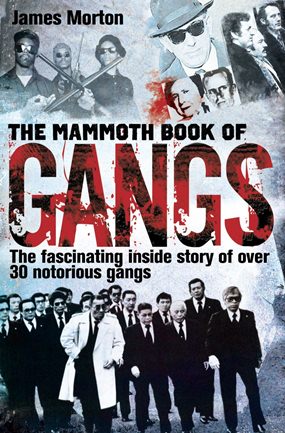If reincarnation is really what’s ahead, then I am sure my past included a spell as a gangster. Why? Because for some unknown reason, I am attracted to the folklore of illegal behavior. Al Capone rings a sympathetic bell for me, as do Clyde Barrow and Bonnie Parker. After watching the Bonnie and Clyde movie, I left the theater with a hatred of policemen, so when I spotted James Morton’s Mammoth Book of Gangs in Bookazine (ISBN 978-1-78033-088-4, 2012, Robinson publishers), and saw that Big Al was mentioned, I had to read it all!
The cover promised “34 notorious gangs” and the introduction set the tone of the book by countering “popular’ concepts of gangsters. The gangster does not hate society, the gangster just wants to rob society!

Unfortunately, the gangsters of the Prohibition era in the USA were all liable to contract lead poisoning, generally from a Thompson sub-machine gun. It was also noticeable that the funerals of the gangsters were well attended, so it was not only me who had an interest in gangsters.
Interestingly, the (in)famous Ma Barker was not the ruthless killer of popular urban mythology, but her sons certainly were.
One common characteristic seems to be their panache. For example, Kid Curry was sentenced to 20 years for train robbery, but two years into the sentence he escaped from the Knoxville prison and escaped on the sheriff’s horse. Panache or just derring do?
Early attempts at changing their appearances were not very successful, being done by some very dodgy doctors. Destroyed finger prints growing back as before one month later. As the law enforcement agencies began to use technology, the gangsters did their best to thwart them.
Many conspiracy theories come to light when popular gangster figures were killed such as John Dillinger, claiming that it was someone else, like the Lord Lucan mystery, or even JFK and Marilyn Monroe.
For many of the gangsters alcohol was to be their downfall. Tongues got loose or they became sloppy in their hiding from the authorities.
Both in the UK and in the US, gangland fights, generally over turf, were just so commonplace that one wonders if it had been safe to be on the streets after 10 p.m.
The 1930’s in Britain were the race wars battlegrounds, with different racial gangs attacking each other and destroying ethnic coffee shops and the like.
Witnesses later becoming unsure of identities, was a common ploy, and one that the police forces were unable to counter. Those with slightly longer memories will recount a tale of a murdered policeman in a Bangkok Club, where none of the eye witnesses were able to identify the alleged gunman. Author James Morton might like to look at the gangland similarities in Thailand, “The Wild East!”
B. 495 for a book of this depth and 493 pages plus a bibliography, the publisher certainly isn’t robbing you blind. If you have a hankering for the high life of the successful gangster, like me, you have hours of enjoyment with this book. But watch out for swarthy gentlemen with violin cases!




